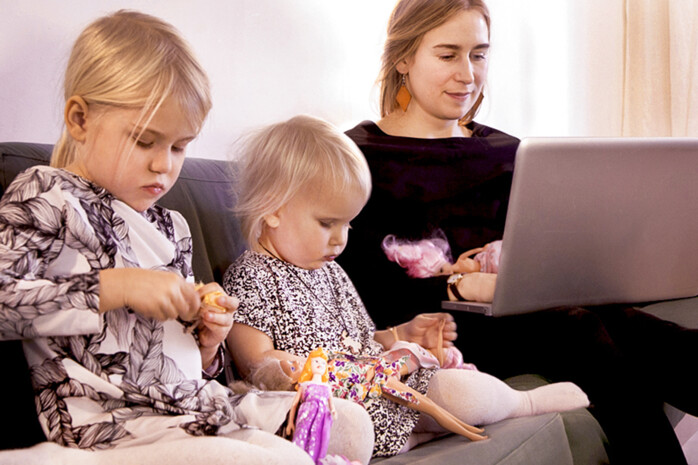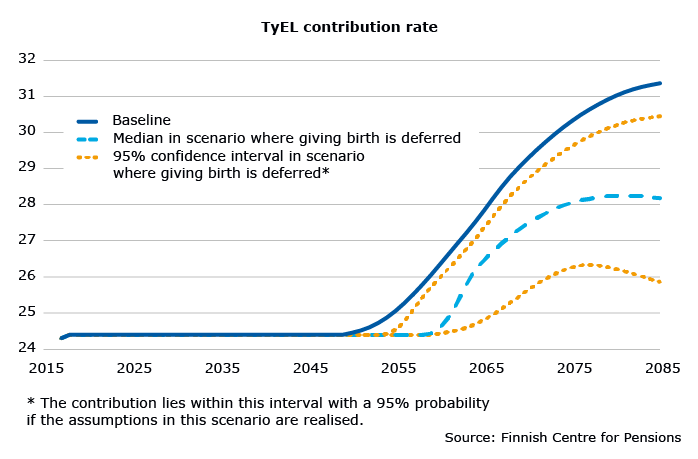Birth rate scenarios: Birth rates likely to slightly rise, which would ease the upward pressure on pension contributions

Finland’s low birth rates can partly be explained by women having children at an increasingly higher age. This is evident from a joint study of the Finnish Centre for Pensions, the University of Helsinki and the Max Planck Institute. If the demographers’ fertility rate scenario was realised, the long-term upward pressure on contributions would fall by half.
Researchers at the University of Helsinki and the Max Planck Institute developed statistical scenario projections for fertility rates in a joint research project with Finnish Centre for Pensions.
The scenarios aim to consider to what extent the already observed decline in birth rates is permanent or temporary by nature.
According to the scenario that the researchers find to be most likely, it is probable that part of the already observed low birth rates are due to women having children at an increasingly higher age. When having children is no longer deferred, the total fertility rate will begin to rise.
In this scenario, there is a 95 per cent probability that the average total fertility rate will be between 1.42 and 1.67 children per woman in the next few decades. In the baseline projection of the Finnish Centre for Pensions, the total fertility rate is projected at 1.35, in line with the population projection of Statistics Finland.
According to the baseline projection, the earnings-related pension contribution (under the Employees’ Pensions Act, TyEL) will have to be increased from the current 24-25 per cent to more than 30 per cent in the latter half of the century. If realised, the rise in birth rates projected in the scenario in which women defer having children would reduce the upward pressure on contributions by half, providing the other assumptions remain unchanged.
“It is very likely that the steep decline in birth rates in recent years will slow down. If that happens, the demographic impact on the level of earnings-related pensions will not be as dramatic as it appears based on current figures,” says director Jaakko Kiander (Finnish Centre for Pensions).
Uncertain future
There is always uncertainty when it comes to projections about the future. The uncertainty can be estimated through confidence intervals.
If the assumptions in the scenario in which women defer giving birth are realised, there is a 95 per cent probability that the TyEL contribution will be between 25.9 and 30.4 per cent at the end of the projection period. In the baseline projection, it is 31 per cent.
“Even if the assumptions concerning birth rates were to be realised, other factors relating to pension financing may vary,” says mathematician Tuija Nopola (Finnish Centre for Pensions).
Statistical fertility scenario projections
- calculated by Jessica Nisén, Julia Hellstrand, Pekka Martikainen and Mikko Myrskylä, demographers at the University of Helsinki and the Max Planck Institute,
- based on data of the Human Fertility Database,
- consider to what extent the already observed decline in birth rates is permanent or temporary by nature.
Scenario in which women defer giving birth: based on an assumption that the trend of deferring giving birth will slow down (most likely scenario according to the researchers)
Alternative scenario: based on the assumption that the current fertility rates of the age groups will remain at the current level (unlikely scenario according to the researchers)

How birth rate scenarios affect pension financing. Finnish Centre for Pensions, Reports 1/2020.
More information
Jaakko Kiander, Director, phone +358 29 411 2414, jaakko.kiander(at)etk.fi
Tuija Nopola, Mathematician, phone +358 29 411 2217, tuija.nopola(at)etk.fi